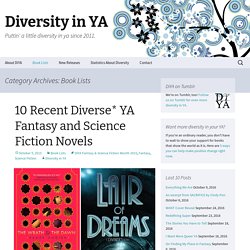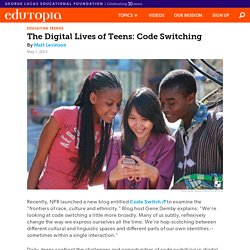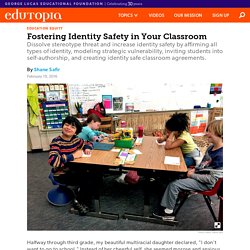

I think there are many teachers, including myself, who need to take a step back and consider the culture, background, and language of each individual in their classroom. This can be a big concept that can get a little overwhelming for some so I am hoping this collection of resources may help explain the importance of addressing identity and sociocultural issues, as well as help teachers, get started in making a change in their classroom. I found projects, like the Peace Library Project, We Need Diverse Books and the Critical Media Project that has made it a goal to teach inclusion and celebrate diversity in the classroom. They provide useful books, lesson plans, and activities to help reach all of our students. I found a few book lists that would be helpful to diversify a classroom library or find books that you may introduce to particular students. This is needed when analyzing the individuals in our classrooms. Alvermann & Hinchman (2012) address the need to engage readers by finding literature in which they can see themselves and relate to the characters' experiences and lives. In addition, within this collection are a few activities that can be used in any classroom- Identity Charts, Where From Poem, My Multicultural Self, and the Social Identity Wheel. These activities reminded me of those mentioned in Alvermann & Hinchman (2012) where students are encouraged to reflect on who they are, their background, culture, and language. One of the most helpful sites for me was commonsense.org which provides an extensive list of resources for cultural and social literacy.
We Need Diverse Books. Teaching at the Intersections. Social Identity Wheel – Inclusive Teaching. Overview The Social Identity Wheel worksheet is an activity that encourages students to identify social identities and reflect on the various ways those identities become visible or more keenly felt at different times, and how those identities impact the ways others perceive or treat them.

Anti-Bias Education Peace Library Project. Know Your Terms: Code Switching. Letting Young People Lead With Their Identities. How Teachers Can See Students' Identities As Learning Strengths. George Sirrakos’ first teaching experience was in the Bronx, and although he grew up in New York City, he had rarely been to the neighborhoods his students called home. As a white, male teacher, his experience growing up as a New Yorker did not mirror those of his students, and he wanted to try out some of the reality pedagogy techniques he learned in Dr. Emdin’s class. Sirrakos said he first tried a core practice Emdin calls “co-generative dialogue,” where teachers select students who represent a variety of classroom experiences to give feedback on the class. The teacher actively listens and solicits solutions students believe would help them. Sirrakos said when he first tried this, students just complained.
“As a new teacher, I was spending a lot of time on my lesson plans, so when you think you’re spinning this brilliance to students and then they spend an hour telling you why this class sucks so much, it’s kind of eye opening,” Sirrakos said. My Multicultural Self. Diversity In YA- Book List. In honor of Women’s History Month, here are 10 diverse young adult historical novels about girls.

Descriptions are from Worldcat. Mare’s War by Tanita S. Davis (Alfred A. Knopf) Teens Octavia and Tali learn about strength, independence, and courage when they are forced to take a car trip with their grandmother, who tells about growing up Black in 1940s Alabama and serving in Europe during World War II as a member of the Women’s Army Corps.
Wildthorn by Jane Eagland (Houghton Mifflin) Seventeen-year-old Louisa Cosgrove is locked away in the Wildthorn Hall mental institution, where she is stripped of her identity and left to wonder who has tried to destroy her life. Critical Media Project. Social and Cultural Literacy Resources for Classrooms. The Digital Lives of Teens: Code Switching. Recently, NPR launched a new blog entitled Code Switch to examine the "frontiers of race, culture and ethnicity.

" Blog host Gene Demby explains: "We're looking at code switching a little more broadly. Many of us subtly, reflexively change the way we express ourselves all the time. We're hop-scotching between different cultural and linguistic spaces and different parts of our own identities -- sometimes within a single interaction. " Activity: Where From Poem. Teaching Strategy: Identity Charts. The Intersection of Reading and Identity in High School Literacy Intervention Classes. This post was adapted by NCTE member Katherine Frankel from her article “The Intersection of Reading and Identity in High School Literacy Intervention Classes” (Research in the Teaching of English, August 2016).

I just bought this book [Confessions of a Serial Kisser] . . . . It’s just about this girl trying to figure out who she is, going to high school, just kissing all the other boys cuz she read a lot of books . . . talking about love and stuff and she just trying to figure out who she is, and the whole book is just trying to find out who she is in high school. . . . I can relate to it, like I’m in high school. . . . It was just an interesting book. —Excerpt from Dennis’s book talk In my research, I have sought to understand how youths are positioned as readers in classes designed to improve their reading by focusing on their acts of agency in these contexts. Fostering Identity Safety in Your Classroom. Halfway through third grade, my beautiful multiracial daughter declared, "I don't want to go to school.

" Instead of her cheerful self, she seemed morose and anxious. "Really? " I asked. Mixing The Digital, Cultural and Social: Learning, Identity and Agency in Youth Participation. Successful students embrace a diverse community – A Guide for Successful Students. Successful student use their college experience to meet new people and gain understanding of others’ viewpoints.

Sometimes, we can have preformed ideas about people who are different than we are and may feel more comfortable with people who are “like” us. However, by starting with being open to getting to know people as individuals, we can break down many barriers and misconceptions. This can help you become a better global citizen as well as better understand the values of multiculturalism that we hold dear in Canadian society.
Multiculturalism involves an attitude of respect for the feelings, ideas, behaviors, and experiences of others who differ from oneself in any way. Learning about different people can help us learn more about ourselves as often our own culture is invisible to us.